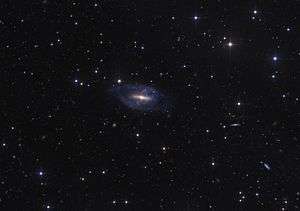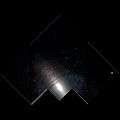NGC 2685
NGC 2685 (also known as the Helix Galaxy) is a lenticular and polar ring Seyfert Type 2 galaxy in the constellation Ursa Major. It is about 50,000 light-years across and about 42 million light-years away from Earth. It is receding from Earth at 883 kilometers per second. It is an object of great scientific interest, because polar-ring galaxies are very rare galaxies. They are thought to form when two galaxies gravitationally interact with each other. "The bizarre configuration could be caused by the chance capture of material from another galaxy by a disk galaxy, with the captured debris strung out in a rotating ring. Still, observed properties of NGC 2685 suggest that the rotating ring structure is remarkably old and stable."[1]
| NGC 2685 | |
|---|---|
 Image by Ken Crawford | |
| Observation data (J2000 epoch) | |
| Constellation | Ursa Major |
| Right ascension | 08h 55m 34.75s |
| Declination | +58° 44′ 03.87″ |
| Characteristics | |
| Type | (R)SB0^+ pec |
| Other designations | |
| Pancake Galaxy, ARP 336, UGC 4666, PGC 25065, PRC A-03, 2MASX J08553474+5844038, MCG +10-13-039, CGCG 288-012, UZC J085534.6+584403, GMM 12 | |
Allan Sandage referred to NGC 2685 as "perhaps the most peculiar galaxy in the Shapley-Ames Catalog".[2]
Gallery
References
-
- Nemiroff, R.; Bonnell, J., eds. (14 March 2014). "Polar Ring Galaxy NGC 2685". Astronomy Picture of the Day. NASA. Retrieved 2014-03-14.
- Sidney Van den Bergh (16 April 1998). Galaxy Morphology and Classification. Cambridge University Press. p. 3. ISBN 978-0-521-62335-3.
- "NASA/IPAC Extragalactic Database - NED". ned.ipac.caltech.edu. Retrieved 2014-02-19.
- "NGC 2685, a polar ring galaxy in Ursa Major | Anne's Astronomy News". annesastronomynews.com. 2013-08-10. Retrieved 2014-02-19.
- Nemiroff, R.; Bonnell, J., eds. (14 March 2014). "Polar Ring Galaxy NGC 2685". Astronomy Picture of the Day. NASA. Retrieved 2014-03-14.


